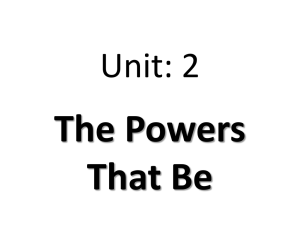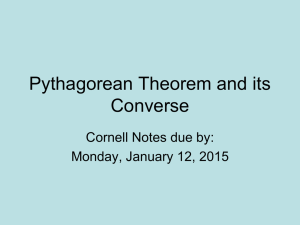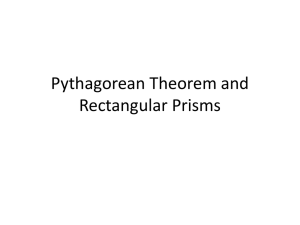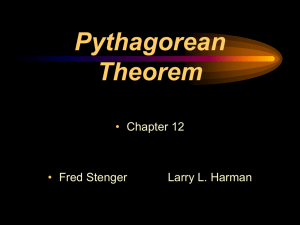Pythagorean Triples
advertisement
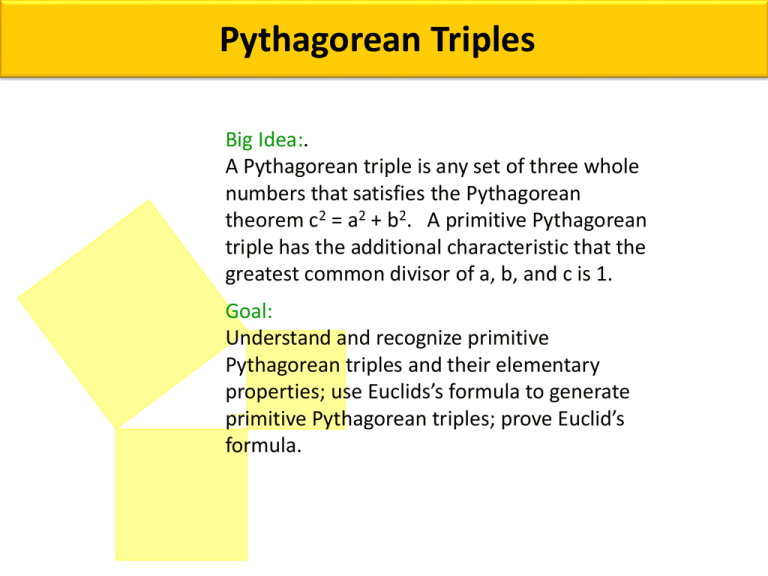
Pythagorean Triples
Big Idea:.
A Pythagorean triple is any set of three whole
numbers that satisfies the Pythagorean
theorem c2 = a2 + b2. A primitive Pythagorean
triple has the additional characteristic that the
greatest common divisor of a, b, and c is 1.
Goal:
Understand and recognize primitive
Pythagorean triples and their elementary
properties; use Euclids’s formula to generate
primitive Pythagorean triples; prove Euclid’s
formula.
Pythagorean Triples
Any set of three whole numbers that
satisfies the Pythagorean
theorem is called a Pythagorean triple.
Examples of Pythagorean triples include
{3, 4, 5}, {6, 8, 10}, and {5, 12, 13}.
(Pythagorean Triples are generally
denoted in brackets of the form {a,b,c}.
Notice that {3, 4, 5} and {6, 8, 10}
represent similar triangles. The sides of
similar right triangles are proportional
to each other. So multiples of
Pythagorean triples are also
Pythagorean triples.
5
3
4
10
6
For any given Pythagorean triple there
exists an infinite number of triples of
the form k{a,b,c}, where k is a constant.
8
Pythagorean Triples
Whole number triples whose greatest
common divisor is 1 are considered
primitive. Thus {3, 4, 5} is a primitive
Pythagorean triple and {6, 8, 10} is
not.
Integers a and b whose greatest
common factor is 1 are said to be
coprime or relatively prime. For
example: 6 and 35 are coprime, but 6
and 27 are not because they are both
divisible by 3.
Pythagorean Triples
Let’s try to find additional primitive Pythagorean
triples. In other words, find a set of positive
integers a, b, and c such that a 2 + b 2 = c 2 where
a, b, and c are coprime.
“Guess & check” is one strategy to find
Pythagorean triples, but it is time consuming.
Euclid developed a formula for finding such
primitives. The formula states that an arbitrary
pair of positive integers m and n with m> n will
form a Pythagorean triple if m and n are coprime
and one of them is odd. The formula is:
a = m2 – n2
b = 2mn
c = m2 + n2 .
Pythagorean Triples
Activity PT #1
Use Euclid’s formula to find three
additional primitive Pythagorean triples
other than {3,4,5} and {5,12,13}.
Activity PT #2
Use basic algebra to prove Euclid’s
formula that c2 = a2 + b2 when
a = m2 – n2, b = 2mn and c = m2 + n2.
Pythagorean Triples
Elementary properties of primitive Pythagorean triples
(c-a)(c-b)/2 is always a perfect square.
Exactly one of a, b is odd; c is odd.
Exactly one of a, b is divisible by 3.
Exactly one of a, b is divisible by 4.
Exactly one of a, b, c is divisible by 5.
Exactly one of a, b, (a + b), (b – a) is divisible by 7.
Exactly one of (a + c), (b + c), (c – a), (c – b) is divisible by 8.
Exactly one of (a + c), (b + c), (c – a), (c – b) is divisible by 9.
Exactly one of a, b, (2a + b), (2a – b), (2b + a), (2b – a) is divisible by 11.
The hypotenuse exceeds the even leg by the square of an odd integer j,
and exceeds the odd leg by twice the square of an integer k>0, from
which it follows that: There are no primitive Pythagorean triples in which
the hypotenuse and a leg differ by a prime number greater than 2.
Pythagorean Triples
Activity PT #3
Select five of the elementary properties
of primitive Pythagorean triples and
prove that they hold true for the three
primitive Pythagorean triples you created
in Activity #1.
Pythagorean Triples
A bit of history…
Around 4000 years ago, the Babylonians and the Chinese used the concept of
the Pythagorean triple {3, 4, 5} to construct a right triangle by dividing a long
string into twelve equal parts, such that one side of the triangle is three, the
second side is four and the third side is five sections long.
In India (8th - 2nd century BC), the Baudhayana Sulba Sutra contained a list of
Pythagorean triples, a statement of the theorem and the geometrical proof of
the theorem for an isosceles right triangle.
Pythagoras (569–475 BC), used algebraic methods to construct Pythagorean
triples. He was not universally credited with this for another 500 years.
The ancient Greek philosopher Plato (c. 380 BC) used the expressions 2n, n2 –
1, and n2 + 1 to produce Pythagorean triples.


